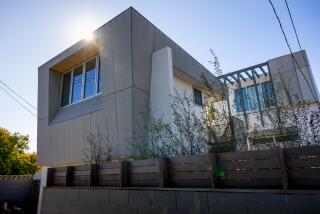Editorial: L.A. needs more housing. Reopening the door to modest ‘granny flats’ could help
With few easy solutions for the city’s persistent housing shortage, it’s no wonder that Los Angeles officials see one answer in “granny flats.” Years ago, the city passed an ordinance that let homeowners add small second units in their backyards. These units haven’t made a dent in the housing crisis (only 591 have been permitted since 2003; only 347 have been completed), but they’ve provided modest dwelling spaces for homeowners’ relatives, friends, employees or even total strangers.
No granny flats are being built these days, however. After a court invalidated the city’s guidelines for second units earlier this year, officials slapped a moratorium on construction to give the planning department and the City Council time to figure out new rules. This has pitted residents who support liberal rules on granny flats against those who worry about bloated second units marring the integrity of single-family neighborhoods.
Here’s the bottom line: Residents are right to worry about the size and location of second units being built in areas zoned for single-family homes. Cramming outsized units onto a block, with some of them visible from the facing street, mars the character of a neighborhood and possibly harms the investments of all the homeowners nearby. But this is not a NIMBY issue; no one is suggesting that second units be prohibited.
In fact, they can’t be prohibited. A 2003 state law effectively gives property owners the right to build second units. Cities can adopt ordinances limiting such things as the size and placement of the units, but if they don’t, the 2003 law allows second units up to 1,200 square feet.
The city’s original ordinance in 1985 allowed second units of not more than 640 square feet. They had to be located behind the main building on the lot and not visible from the street. Notably, the ordinance gave the city the discretion to deny permits for units even if they met its size and placement requirements. The 2003 state law, however, denies local governments such discretion, although it allows them to adopt size limits and other restrictions.
City officials decided to enforce the limits set by the 1985 ordinance, while recognizing the right of property owners to build any second unit that complied with those restrictions. Concerned about the conflict with state law, however, the city’s chief zoning administrator wrote a memo in 2010 instructing city staffers to follow the default state guidelines, which meant allowing second units almost twice as large as had been permitted — larger, in fact, than many single family homes in the city. That dictate remained in effect for about six years until a Superior Court judge in Los Angeles threw out the memo, holding that state law did not preempt the size limit set by the 1985 ordinance. The judge left it to the city to decide whether to amend the ordinance to recognize property owners’ right to build second units, as per state law, or to repeal the ordinance and default to the guidelines set by the Legislature.
The second option is what the city council’s Planning and Land Use Management Committee is recommending to the full council. Why? Because it’s easy.
That’s not a good reason. Certainly, the city should lift the moratorium and grandfather in every completed unit and construction project that conformed to the now-defunct zoning memo. People who followed the rules at the time should not be punished because the rules changed.
But beyond that, the smart option is to return to the reasonable size and location restrictions in the original ordinance on second units. It is not heavy lifting to change the ordinance to reflect the rights that state law gives property owners. While the city is appropriately eager to generate more affordable housing, shoehorning oversized second units behind single family homes is not an effective way to accomplish that.
The city’s planning department suggests crafting more up-to-date standards for second units. That’s a fine idea — but it will take months or even years of research, public hearings and negotiations. In the meantime, the City Council should vote to revise its original ordinance, hew to its stricter guidelines and allow anyone who meets them to build. This will provide secondary units of a substantial size that still fit into the single family neighborhoods in which they are being built, while forcing those who want bigger units to seek variances. That’s a sound approach until the city can come up with better, more nuanced guidelines.
Follow the Opinion section on Twitter @latimesopinion and Facebook
More to Read
A cure for the common opinion
Get thought-provoking perspectives with our weekly newsletter.
You may occasionally receive promotional content from the Los Angeles Times.






